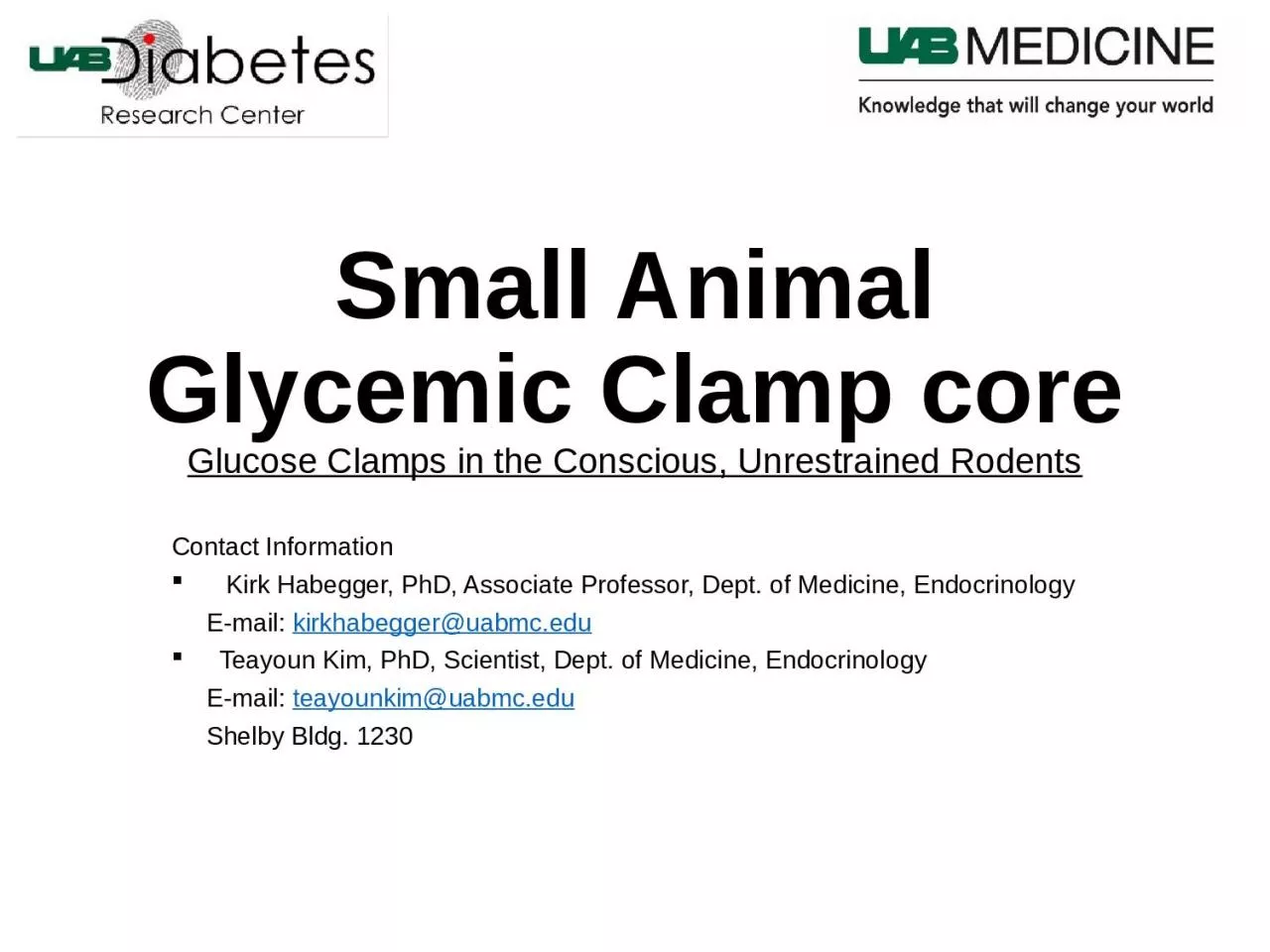

Glucose Clamps in the Conscious Unrestrained Rodents Contact Information Kirk Habegger PhD Associate Professor Dept of Medicine Endocrinology Email kirkhabeggeruabmcedu Teayoun Kim PhD Scientist Dept of Medicine Endocrinology ID: 1030287
Download Presentation The PPT/PDF document "Small Animal Glycemic Clamp core" is the property of its rightful owner. Permission is granted to download and print the materials on this web site for personal, non-commercial use only, and to display it on your personal computer provided you do not modify the materials and that you retain all copyright notices contained in the materials. By downloading content from our website, you accept the terms of this agreement.
1. Small Animal Glycemic Clamp coreGlucose Clamps in the Conscious, Unrestrained RodentsContact Information Kirk Habegger, PhD, Associate Professor, Dept. of Medicine, Endocrinology E-mail: kirkhabegger@uabmc.eduTeayoun Kim, PhD, Scientist, Dept. of Medicine, Endocrinology E-mail: teayounkim@uabmc.edu Shelby Bldg. 1230
2. The Gold Standard for Assessment of Insulin SensitivityInitially developed to investigate insulin sensitivity in humans, the hyperinsulinemic-euglycemic clamp procedure has been adapted to other species, such as apes, dogs, rats, and mice. This procedure provides a mechanistic interrogation of insulin action in the intact rodent, which uncovers mechanisms underlying pathologies and novel therapeutic interventions. During the clamp, hyperinsulinemia is achieved by a constant insulin infusion through an indwelling venous catheter. Blood glucose is measured via an indwelling arterial catheter allowing both infusion and sampling to occur in the conscious, unrestrained rodent with minimal stress.Euglycemia is maintained throughout the study via a concomitant glucose infusion at a variable rate (GIR), and provides the primary measure of whole-body insulin action, as animals with enhanced insulin sensitivity require a greater GIR.
3. Figure 1. Depiction of the experimental setup for Cold (A) and Tracer-based (B) clamps. Infusion and sampling time-line during a typical glucose clamp experiment.Figure 2. Current experimental setup for glycemic clamping in mice (A) and rats (B).(A)(B)(C)(B)(A)
4. Services OfferedIndwelling catheter cannulation Jugular vein (insulin, glucose, tracer infusion) Carotid artery (blood sampling; patent up to 2 weeks)In Vivo Glucose-Stimulated Insulin Secretion (GSIS)Ex Vivo adipose tissue glucose uptake iWAT, eWAT, gWAT with [3-3H]-2-Deoxy-D-glucose & insulinHyperinsulinemic-Euglycemic Clamp / Hypoglycemic Clamp / Hyperglycemic Clamp Glucose infusion rate (GIR), Glucose disposal rate (Rd) Tissue-specific (2-Deoxy-D-glucose) uptake (Rg) Hepatic glucose production (Endo Ra), Tissue-specific Glycogen synthesis Insulin signaling Western Blot from tissues snap-frozen at clamp terminationIslet studies Islet isolation, Ex Vivo glucose-stimulated Insulin Secretion (GSIS)Primary cell isolation from mouse tissues Hepatocyte, Adipocyte
5. Figure 3. Blood glucose (A), GIR (B), glucose disposal (C), endogenous glucose production (D), plasma insulin (E), glucose uptake (F-G), and glycogen (H). Representative data from tracer-based hyperinsulinemic-euglycemic clamp with somatostatin-blockade of endogenous insulin secretion (Kim et al. Diabetes 2018). (A)(B)(C)(D)(E)(F)(G)(H)
6. Figure 4. ex vivo adipose tissue glucose uptake in mesenteric and inguinal white adipose depots treated with 50 nM insulin for 20min. Data represent mean ± SEM (n = 8-9 mice/ group). *p< 0.05, ** p< 0.01, *** p< 0.001, in 2-way ANOVA.Figure 3: Plasma insulin (a) in male C57Bl/6J mice (n=7-8) pre-treated 60 min with IUB288 prior to 1mg/kg i.v. glucose. Immunofluorescent labeling of insulin (green), glucagon (red), and somatostatin (blue) in islets from 5h fasted mice treated with GCGR agonist IUB288 for 14 d (b). Fold insulin secretion in islets isolated from chow-fed mice treated 4d with IUB288 or vehicle (c). IUB2882 = islets from IUB288-treated mice, then exposed to IUB288 during 16.5mM glucose stimulation. Data represent mean ± SEM. *p< 0.05 in 1-way (b) or 2-way (a) ANOVA.